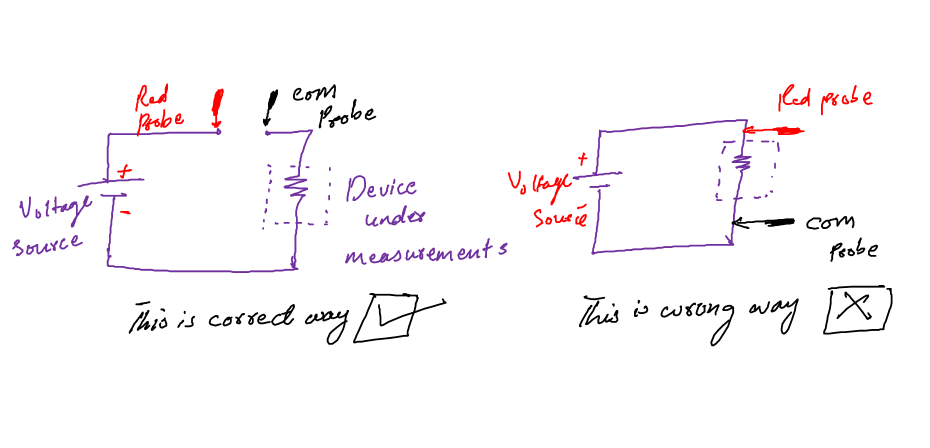Electric current is the flow of charges when a voltage is applied and the circuit is complete. The instrument for measuring current are an Ammeter, a multimeter, and a clamp meter.
The selection of instruments for current depends on the situation, value, and the nature of current. For example, if we are measuring low value DC current a simple multimeter or an Ammeter is fine. But if we are measuring AC currents with high values then we would definitely use a clamp meter.
To measure current we need to connect the meter in series with the path of current. But for the clamp meter, we can use the electromagnetic fields around the wire to accurately measure the current value.
If the above short introduction has got your attention, then I am sure you will find the rest of this article very helpful.
Hi, I am Abbas. In the rest of this article, I will explain the above in detail. Also, I will share what is different types of current. Which instruments are best for which situation? How to use the current instruments. What are the safety measure when you are working with high currents, and so much more.
I am not perfect, nor this article is going to be. This is just my limited knowledge try to help you somehow.
I hope you will enjoy it.
Instrument for measuring current
By definition, we can say that electric current is the time rate of flow of charges in a complete circuit. These charges are electronics to be very specific.
The interesting point to note is that the current flow from higher potential to lower. Meaning that electrons flow from the negative terminal of the voltage source toward the positive terminal – this flow is electronics current.
But you may have seen in textbooks that the current is shown such that it flows from the positive terminal toward the negative terminal – this is called conventional current.
We will follow the conventional current, but now you know that in reality, electrons flow from negative to positive.
Now to measure this electronic current we need some tools and instruments.
These tools are:
- Ammeter
- Multimeter
- Clamp meter
I believe in properly understanding these tools first we need to talk about the different types of current, i.e., AC and DC.
If you are not a beginner and already know about these things, you can for sure skip these sections. But it would make me happy if you read them once. I believe you will definitely learn a few new things from it.
AC
Any electrical signal is generally defined as any function of time that carries information about a certain electrical phenomenon. The information may be the frequency of the signal, behavior, or signal amplitudes.
Now the electrical phenomenon may be a voltage or current phenomenon, and that is why we call the mentioned phenomenon as voltage and current signals respectively.
We specifically define alternating signals as signals that have changing polarity and changing amplitude over time. By changing polarity I mean the changing direction, sometimes time they are positive and sometimes negative. Let’s see the following example.
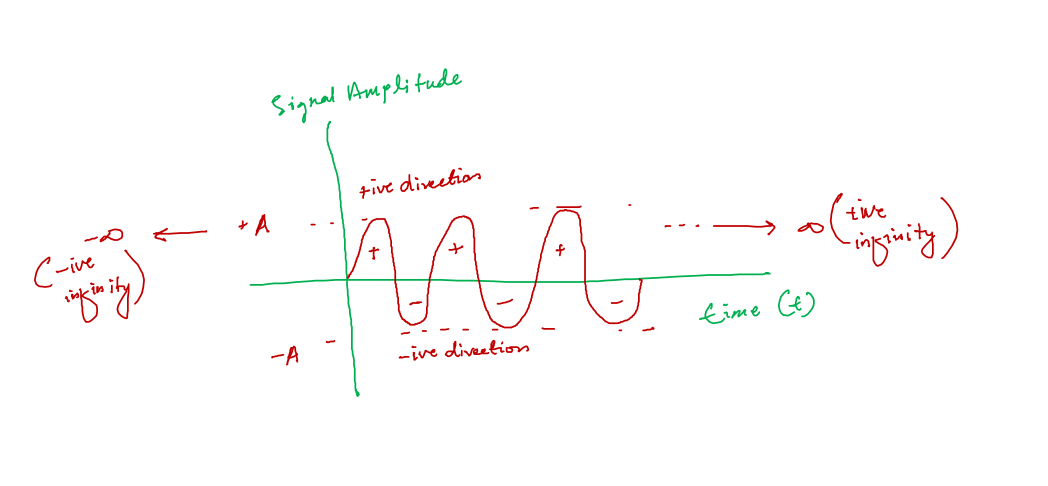
You see the polarity of the above signals is varying with time, for some time it is positive and for some time it is negative.
Also, you can clearly see the amplitude of the signals is varying from zero to A, from A to zero, and again from zero to -A. We call such signals alternating signals.
Now voltage and current may be alternating:
- Alternating voltages (AV)
- Alternating current (AC)
The electricity we get from a home socket is alternating (Sinusoidal) in nature and that is why we call the current from those sockets AC. The typical values of alternating voltages in these sockets are in the range of 220 to 240V(RMS).
Alternating current (AC) is produced by AC generators, big hydel dames, and the list goes on.
We measure AV and AC signals in RMS value because we cannot take the average value of these signals and measuring the instantaneous value doesn’t make any sense. Instantaneous value is sometimes zero, the other time A, the other time -A, so this is the reason we don’t go for these values.
DC
These signals are opposite to the alternating signals. They don’t change their polarity with time, sure their magnitude may be varying with time.
When its amplitude or magnitude is not varying we call such signal the constant signals. And when working with electronics we sometimes, actually most of the time, prefer the contact signals.
Let’s see an example of a direct constant signal.
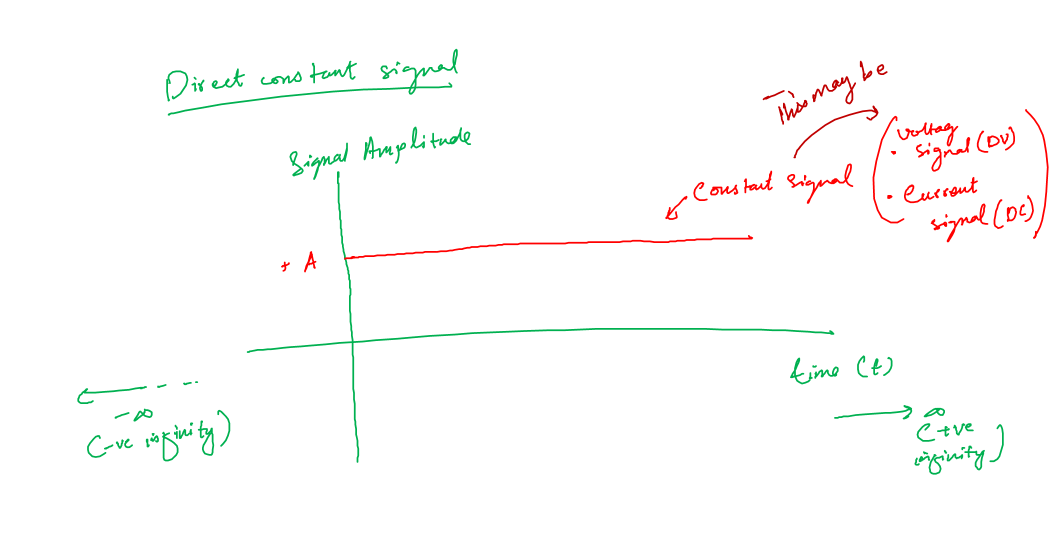
You see the signal amplitude is constant. The above was about the general signals, now if apply this concept to voltage and current we have:
- Direct voltages (DV)
- Direct Current (DC)
The sources of DC are batteries and DC generators. We can also convert AC into DC, so alternately we can say everything that produces AC is also the generating source of DC.
In our homes, we pay for AC electricity. But almost every device we use in homes is working on DC. So we use the AC to DC conversion to make our devices work.
So why we can’t design all the devices operating on AC? The answer is we cannot store AC. For example, if we design our phone just for AC, then it would not be possible to carry it everywhere. DC can be stored in batteries and that is why our phones have batteries.
Difference between AC & DC
Now that we have the concepts of both AC and DC. It would be good if try to understand some other differences as well.
- AC cannot be stored but sure we can store DC
- AC is less lossy over long distribution wires while DC is very lossy in such situations. That is the reason electricity (current) coming to our homes is AC, not DC.
- AC levels can be changed simply just by using a single transformer, while it is complicated to change the DC signal levels.
List of Instruments for measuring current
Alright!
I think I have shared enough about AC and DC. Now let see what are the right tools for each of them.
1. Ammeter
The unit of current is Ampere. This is the reason this meter is called Ammeter. Because it measures Ampere.
I personally believe Ammeter is good to know, but I would not recommend it when we have a lot a digital instruments like multimeter. Also, this meter is very limited. You cannot use it for high current values and amplitudes.
We have integrated the function of Ammeter in multimeter and clamp meter. For this reason if we have a multimeter we really don’t need a separate Ammeter unless we are just collecting it for fun.
2. Multimeter
You know, like a doctor having their stethoscope all the time, a multimeter is a tool electronics engineers will have all the time. The difference is, you can’t use it on patients.
A multimeter is a measuring device, used to measure the following quantities.
- The resistance of a resistor
- The capacitance of a capacitor
- Voltages
- Currents both AC and DC
- Continuity test
- The temperature of a component
There are two types of multimeters. One is called an auto-range multimeter, and the other is called a manual range multimeter.
The difference is, auto range multimeter automatically sets its measuring range while in the latter one you have to set the range yourself. Basically, the auto range multimeter is awesome and very smarter than the other one.
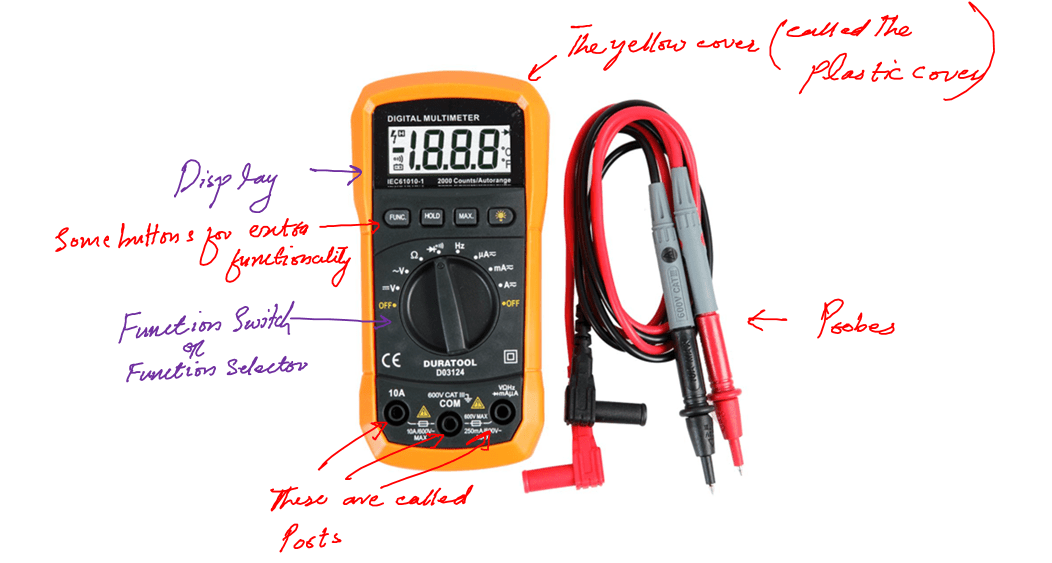
In every multimeter there is a dial or the nobe, called the selector switch, using which you set the range.
Measuring current using multimeter
Now let’s talk about the step by step procedure that you can follow to measure the current accurately:
- Take your multimeter and probes.
- Connect the black probe (Negative) to the COM port (A port in multimeter with written COM on it) and the red probe (Positive) to the “mA” written port.
- Now here is the thing, if you want to measure small current like below 1A, then use the “mA” port. But if you want to measure more than 1 A current, use the port with written “A” on it.
- Align the function selector button to the “A” label. A is used as Ampere, the SI unit of current.
- Connect the probes in series where you want to measure current. This is important, don’t put the probes across the device. See the following diagram for reference.
- Now if you want to measure alternating current (AC) align the function selector to “A∼” or to “A−” if you want to measure DC.
- In the auto range meter just align the function selector to the current sign (AC or DC) and get the reading immediately on the digital display.
So yeah this is all I got for you on how to use a multimeter for current measurements.
3. Clamp meter
Sometimes we work in the field and deal with high value and amplitude signals. These signals may be voltage signals and current signals.
There it is not easy and safe to go with traditional measurements like a multimeter we saw above. We need a safer multimeter, called the clamp meter. These meter uses electrical induction methods to measure currents.
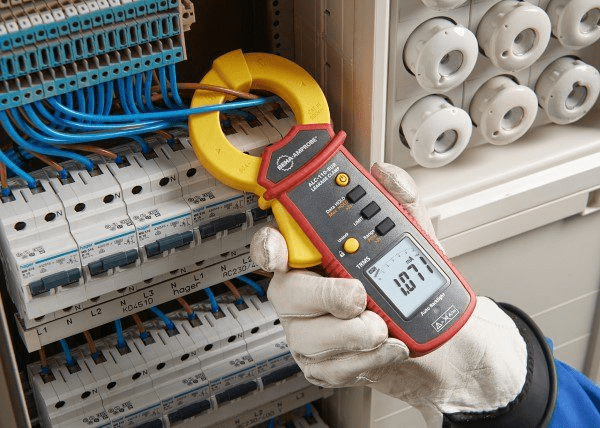
Clamp meters are digital meters except they are used in a different environment where safety is a priority.
They can measure voltages and currents both AC and DC. But they are specifically used for AC current measurements. It can also measure resistance and some other quantities as well.
Measuring current using multimeter
In the clamp meter, there are no probes all you have to do is just grab the wires inside its upper jaw, select the Current function (AC or DC), and get the results on the display. Always wear a protected pair of gloves when working with this guy.
Safety measures when measuring current
In the electronics circuit, voltages are measured across different devices in the circuit. So, it is good practice to buy different types of probes so that you don’t face problems while analyzing your circuit.
Never ever put a multimeter in voltage setting across the current source, it will damage your multimeter right away.
Always wear a protected plastic pair of gloves when working with high value current especially AC type.
Conclusion
To measure current we need some tool and instruments. The best instrument for measuring current are:
- Ammeter
- Multimeter
- Clamp meter
These tools are good to measure current in different situation. Like we prefer to work with multimeter for small in lab currents. But when it comes to high AC current we don’t use multimeter.
Why?
Because to measure current we require connecting the multimeter in series. For series connection we would cut the wire. And this is what we don’t want to do. Like why, I would cut the wire coming to a building or home with such high current to measure current.
So to handle this situation we use clamp meters. These meter use electromagnetic field to measure the current which is for more effective and safe.
Know how we use these instruments to measure current. The answer is simple, connect them in series and select the proper function on the meter. For clamp meter just pass the wire in its clips and take the readings.
Of course this is just a short summary I have explained these in detail in the above article.
So that is it. That is all I have for you about some of the top instrument we use for measuring electric current in a circuit. Please be careful when dealing with high currents they can seriously harm you.
I hope you enjoyed my limited knowledge effort to help you somehow. I am really hoping that I answered your query for which you came here. Thank you and have a grateful life ahead.
Other useful posts:
- Multimeter basics for beginners – Learn how to use a multimeter
- How to measure USB current and voltage (Practical solution)
- How to test capacitor without desoldering [in circuit testing]

